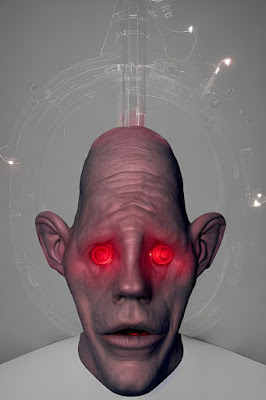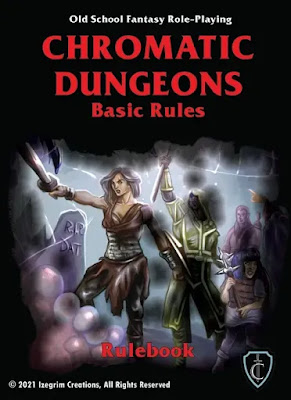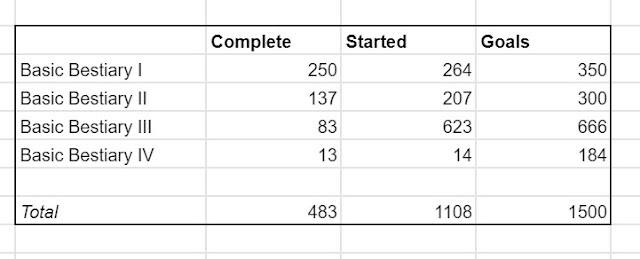Dragon #125 comes to us from a magical time in ancient history known as the Fall of 1987. This issue is from September 1987 in particular. I just met this girl from the dorm next door. She had already kicked everyone's ass in cards in her dorm and now she was over at mine to humiliate everyone here. So yeah we quickly became friends, then best friends and sis years later we were dating and today is our 26th wedding anniversary. So yeah, I look back at this time rather fondly.
Dragon #125's special feature is Chivalry. Not a bad choice with all the Arthurian movies I have been watching this month. The cover art by Roger Raupp is a great portrayal of Arthur vs Modred.
Letters include one to remind us the Wormy has appeared in 100 issues at this point. Sadly the end is near. Also mentioned is Finieous Fingers which hadn't appeared in Dragon for a long time. There is also a letter about religion in D&D and the DragonRaid game gets mentioned.
Nice ad for the Science Fiction Book Club. This would have been around the time I joined for the second time and I see a number of books here I still have. This was my transition phase of moving out of dark fantasy and into horror proper.
Forum has the usual collection of deep cuts for the game. One, in particular, discusses a letter from #121 about parthenogenesis in Amazons and delves into the details of the mating habits of harpies. Is this Dragon Forum or Penthouse Forum? Likely to have the same level of "Dear Editors, I could not believe this, but this really happened..."
The first true article comes up and it is a neat one. Nigel D. Findley gives us The Ecology of the Greenhag. The central idea revolves around the notion that all hag types are born of the mating of a Night Hag and various humanoid species. It is a neat idea really. I like that the Night Hag has a gestation period of 13 months. Greenhags likewise can give birth to an Annis after their "quite frequent" matings with ogres or hill giants. No indication on how the Sea Hags or other hags fit into this.
Ed Greenwood is up with a Realms article. This was the start of the Golden Age of the Forgotten Realms. The article, Woodlands of the Realms, covers magical and mundane trees and forests of the Forgotten Realms. You have to give the guy credit, he came up with some good stuff even in the minutia such as this.
Our special section of Chivalry begins next.
The Code of Chivalry by Mark Easterday gives us some knightly orders and what to do with them. There are benefits and drawbacks for PC Knights and even a simple system for honor. It is nothing Earth-shattering, but it has appeal in it's simplicity. It is also something more people should be doing with knights, cavaliers, and paladins.
Nice big ad for the Time-LIFE Mysteries of the Unkown series, now frustratingly incomplete at your local used book store.
Thomas M. Kane is next with Meanwhile Back at the Fief... This one covers all the duties of a feudal lord. There are some details on day-to-day activities and tables of odd occurrences. I seem to recall some similar rules in the D&D Companion set. These came after that so I wonder how they compare.
Armies from the Ground Up by James A. Yates is next and deals with the hows and whys of raising an army in an AD&D game specifically. Again, very useful to have.
A "new" section that was going to be semi-regular is up, Lords & Legends. I have no idea how much or for how long it continued. A quick Google search shows it came up at least one more time. This is entering as bit of a "Dark" time for me and Dragon. I was in college and any spare money went to food, school supplies, or...other school supplies. It is "dark" in the sense that it is a period that is unknown to me. I remember reading this issue back then, but my Dragon purchases would be only for special occasions like the October issues.
For this Lords & Legends from Katharine Kerr we have three lords of the Age of Chivalry; Count William of Orange, Bertrand (nephew of William), and Count Rainouart of Tortelose. All from the Chanson de Roland ("Song of Roland").
Our last article in this series is Glory, Danger, and Wounds by Garry Hamlin. This article also draws on The Song of Roland for inspiration and deals with battle and honor for Cavaliers. Large battles and private duels are discussed. More importantly how such battles and duels should and should not be used.
The Best for the Best covers elite espionage agencies for Top Secret and is a rare non-Merle M. Rasmussen article. This one is from William Van Horn and it is more proper for the Top Secret S.I. game that Rasmussen did not develop.
For our centerpiece, we get a new "mini" game from David "Zeb" Cook, Clay-O-Rama, a miniatures battle game where the playing pieces are made from clay or Play-doh. You get some friends, some dice, some pencils, and some modeling clay (Play-Doh is recommended) and you get started making your Claydonian to do battle. Make sure you leave some clay/playdoh aside for missiles The rules are really simple, you move, you attack, you calculate damage. The whole thing takes up three page and a cover. Pull it out of your magazine and you are good to go. It does look like silly fun, to be honest.
Our fiction selection is by Lois Tilton titled The Passing of Kings.
Lee Ian Wurn is up with a rare post-Gary Greyhawk article. In the Bazaar of the Bizarre, we have the Magical Maps of Greyhawk. We get magical maps that more or less are the magical GPSs of their day. The article though gave me an idea. What if there was a giant magical Bazaar, like what you find on Deva in the Myth Adventures books by Robert Lynn Asprin. I could make each article a stall, like you find in those giant flea markets or the vendor's room at Gen Con. And just to be that guy, the stalls have the same number of the magazine they appeared in. This shop of magical maps is found in stall #125.
Jeff Grubb is up with Plane Speaking. This time featuring the Positive Quasi Elementals. There are only three, Radiance (Fire-Positive), Steam (Water-Positive), and Mineral (Earth-Positive). The Lightning (Air-Positive) appeared in the Monster Manual II.
The Game Wizards talks about the new Dragonlance Adventures hardcover. This was a rather popular book with my small group in college. There were a lot of ideas I freely stole from it for my own games. I also thought it was odd about the hard cap of 20 levels. Now that is normal.
A Second Look at Zebulon's Guide comes to us from Kim Eastland and covers all sorts of errata and clarifications. I was out of Star Frontiers at this point having switched over to FASA Doctor Who and Star Trek. I have heard that Zebulon's Guide changed things but I will admit I do now know to what degree.
Big ad for Mayfair's updated City-State of the Invincible Overlord
Role-Playing Reviews is next covering three fantasy adventures. This is another one of the articles that would get WotC into trouble despite their good intentions. The article is Copyrighted 1987 by Ken Rolston, which means he likely still held the reprint rights. The adventures in question are The Grey Knight for Pendragon, Phantom of the Northern Marches for MERP, and Treasure Hunt for AD&D. We learn something we had suspected at this time, that the term "Module" was growing out of fashion. So for the adventures Rolston lets us know that the Grey Knight is one of the best he has seen, Treasure Hunt is a fantastic adventure for 0-level AD&D characters, and Phantom is wonderful.
The Role of Books covers some of the new releases for the last quarter of 1987. There is the Orson Scott Card's Seventh Son, a couple from Harry Turtledove, and the debut (more or less) of Peter David who later go on to be one of America's most prolific authors.
Jeff Grub's Marvel-Phile is up with some enemies for the Incredible Hulk; Abomination and Zzzax, and an ally, Doc Samson. I was thinking about Abomination just the other day while trying to decide if I should include the Hulk movies in my Marvel re-watch that I might never get around to.
Gamer's Guide has the classified ads. I wonder how many of these places were still around.
Convention Calendar covers the cons of Fall 1987.
Three pages of Snarf Quest, a page of DragonsMirth, and three of Wormy.
Some interesting bits to be sure, but nothing that jumps out to me to be used today. The Greenhag stuff is fun, but I have taken my hags into a completely different direction really. While everyone talks with glowing nostalgia for the Dragons prior to these (and I do as well) there is a lot between 1987 and 1997 that I never read and only have briefly glanced at. So that might be my new sweet spot for The Old Dragon.


























